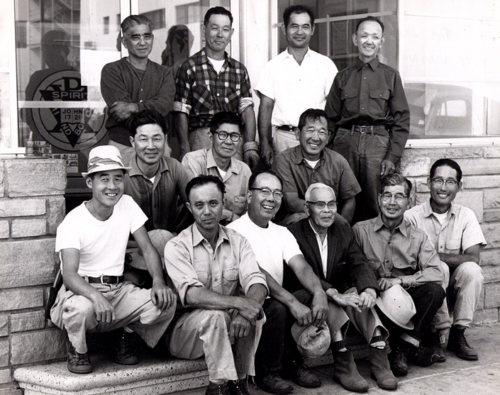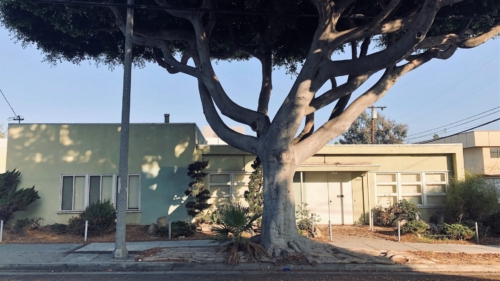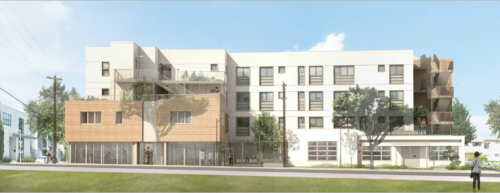Santa Monica Nikkei Hall

- Known As
- Nikkei Jin Kai, Mid-Century Modern Institutional
- Architect
- Yoshimi Tom Makino
- Built
- 1957
- Designated
- 2018
Japanese immigrants first established a community in Santa Monica in the early 1900s with a thriving fishing village in the Santa Monica Canyon, providing restaurants in Los Angeles with their catches. The Nikkei (people of Japanese ancestry) population attended Santa Monica schools and later transitioned to agriculture, gardening and nursery services. Their community expanded throughout the central Santa Monica and Ocean Park.
Following the bombing of Pearl Harbor on December 7, 1941, an executive order forced Nikkei living on the west coast into internment camps. Santa Monica’s Nikkei residents were sent to camps in Manzanar and Owens Valley, resulting in the loss of their homes and businesses. When they were able to return home in 1945, fewer than 200 Nikkei returned to Santa Monica, while others came back only after settling in the Midwest or east coast. Facing a housing shortage, the Nikkei rebuilt their community in the Pico Neighborhood.

Leaders of Santa Monica Nikkei Hall in November 1965. Back row, from left: Eddy Uyemura, Tom Endo, S. Naoye, Mr. Abe; middle row, from left: Yutaka Ohigashi, S. Takahashi, G. Dote; front row, from left: H. Ishiwata, F. Makuta, Tom Matsumura. Mr. Sakata, Mr. Ichiho, Mr. Nishimura. Photo: The Rafu Shimpo
In 1951 a group of Issei (Japanese-born immigrants) leaders formed the Santa Monica Nikkei Hall, Inc. and purchased property at 1413 Michigan Avenue. They circumvented alien land laws by listing members’ American-born sons on the deeds. The Santa Monica Nikkei Hall was constructed in 1957 to house the activities of the social organization of the same name. The architect was Yoshimi Tom Makino, who was born in Berkeley, CA and studied architecture at University of Southern California. Makino was incarcerated at a camp in Rohwer, Arkansas where he worked as an architect for the War Relocation. By 1956, he reestablished his architecture practice in Los Angeles. His other designs include the West Los Angeles Buddhist Church (2007 Corinth Avenue, 1954), the San Fernando Valley Hongwanji Buddhist Temple in Arleta (9450 Remick Avenue, 1961) and additions to the Japanese Institute of Sawtelle (2110 Corinth Avenue, 1963).
The modest one-story social hall and residence was designed in the architectural style known as Mid-Century Modern Institutional. The hall has undergone few changes since its original construction, with the exception of an apartment added to the rear of the structure in 1969.
It was here that Nissei (American-born Japanese) families gathered and socialized, connecting with their heritage, celebrating holidays, conducting funerals and receiving support services. A decade later the use of the hall decreased significantly as these families began to move out of the area. By 2000, the Hall was used mostly by senior citizens and had dwindled to only a handful of members by 2017.
The property was sold, with proceeds donated to local community and religious organizations who have been entrusted to preserve and maintain the Ireito, a 15-foot-high granite memorial in nearby Santa Monica’s Woodlawn Cemetery. The memorial honors the first-generation of Japanese who settled in the Bay Cities region of Southern California. It now also represents generations of Japanese Americans, including those who served in the U.S. military.
The Landmarks Commission initiated and designated the shuttered community center as a historic landmark in 2018 for its cultural significance. The structure was saved from demolition when a member of the Landmarks Commission familiar with local history reported the significance of the unimposing building in the lives of the Santa Monica’s historic Japanese-American community. Now that the Commission has lost its demolition review responsibility during Santa Monica’s fiscal emergency, residents need to watch for cultural and historic sites and features with important histories that could be jeopardized by impending demolition and call them to the attention of the Conservancy and the Commission.
With the purchase of the corner lot by nonprofit organization EAH Housing in 2019, the Nikkei Hall entered a new phase. The historical building is being incorporated into The Laurel, a 58-unit affordable housing project designed by KFA Architecture. It is scheduled to begin construction in the fall of 2021 and will be completed in spring of 2023. The integration of a modest historical building into a larger contemporary complex required particular care and an approach rooted in respect, deference and creating an architectural and spatial dialog between new and old.
The historical building is separated from the surrounding L-shaped structure by a central courtyard, providing a green buffer between the structures and a gathering space for tenants. The new building steps down at the corners, reducing the mass toward Michigan Avenue and allowing light to penetrate to the center of the project and Nikkei Hall, and is canted deferentially to the historic structure. The larger mass behind Nikkei Hall features subtle references to its design, including horizontally oriented panels to pick up on the lines of the character-defining windows at the front of the hall. The historic building will be rehabilitated as a manager’s unit and a community room, establishing a line of continuity in the use of the Hall.
As a whole, the Japanese community center will receive more of the attention it deserves with a respectful larger building and landscaped open space surrounding it, rather than being surrounded by a large parking lot. The Landmarks Commission gave its enthusiastic support for the project and unanimously approved the design. Nikkei Hall’s history and status as a landmark will be enhanced by proper refurbishment, a commemorative plaque, adaptive reuse and the complementary design of the new structure, as well as being part of a project providing much needed affordable housing for the City.
This project preserving and incorporating Nikkei Hall is a promising model for adaptive reuse, along with other sites like Hostelling International and the Rapp Saloon.

